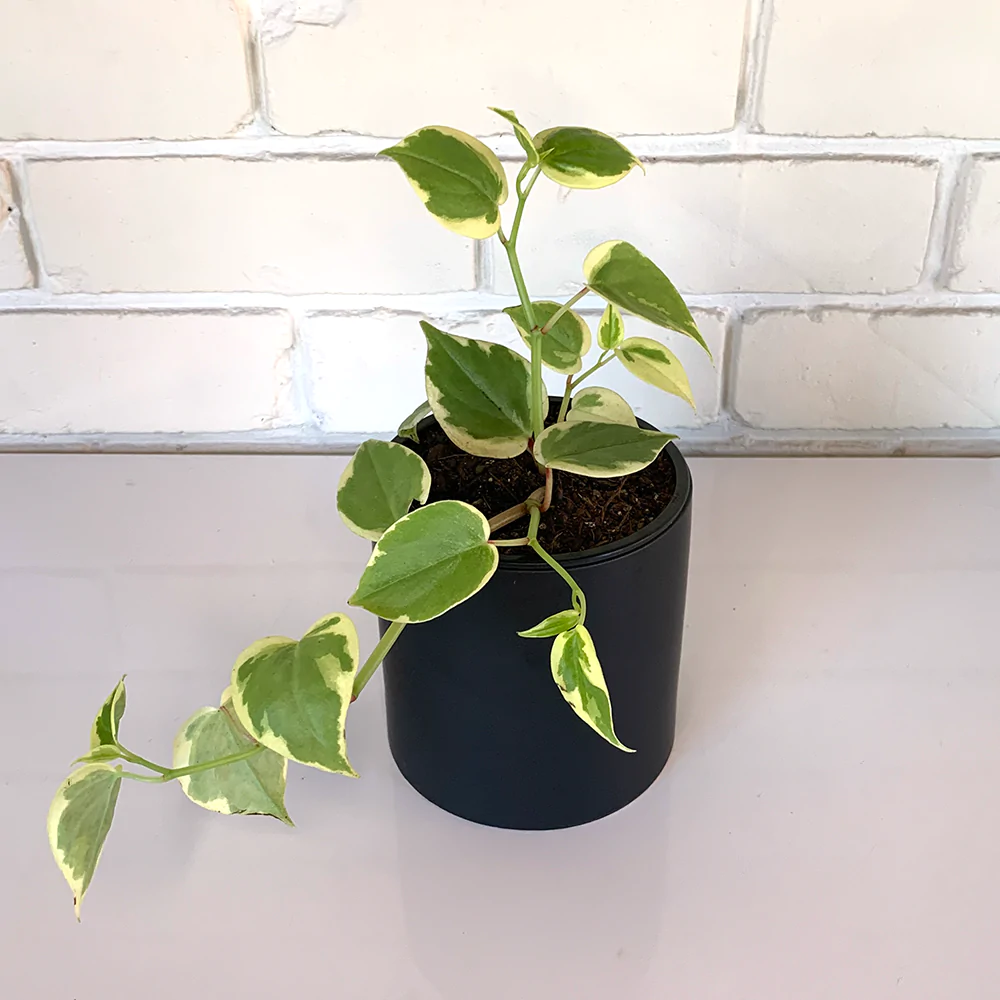Peperomia scandens or Piper Peperomia is a vining, epiphytic plant. It is a famous houseplant because of its strength and simplicity of care. Peperomia is a durable trailer with glossy green, heart-molded leaves. Small, green blossoms are borne on spike inflorescences that look like rats’ tails.
This perpetual epiphytic plant is an individual from the Piperaceae group of plants. It is a relative of the typical pepper plant. The name of the plant genus, Peperomia, joins the Greek words, homoios and peperi, signifying “like pepper.” The particular appellation, scandens, represents “rambling or climbing.”

Characteristics of Peperomia Scandens
Peperomia Scandens grow a fast developing, following/climbing plant that can achieve a stem length of around five feet with a spread of around 12″ inches at the base of the plant.
The plant is semi-succulent and has glossy green, heart-shaped leaves with pinkish stems to store water.
The branches are very tough and rigid. The plump leaves are thick, green, and shiny with pale boundaries. Scientific characteristics of Peperomia Scandens are as follows:
| Scientific name | Peperomia Scandens |
| Family | Piperaceae |
| Genus | Peperomia |
| Habitat | Mexico and South America |
| Varities of Peperomia | 1000+ |
| Common names | Vining peperomia, Cupid peperomia, False Philodendron, Radiator plant, Hanging Peperomia |
Most famous species of Peperomia plant includes
- Peperomia obtusifolia (Baby Rubber Plant)
- Peperomia argyreia (Watermelon Peperomia)
- Peperomia rotundifolia (Trailing Jade Peperomia)
- Peperomia clusiifolia (Peperomia Jelly)
- Peperomia Scandens (Cupid Peperomia)
- Peperomia orba (Teardrop Peperomia)
Care Guide for Peperomia Scandens
The most awful sight for any gardener is to see their dearest plants kick the bucket. If your Perperomia Scandens plant is biting the dust, the top variables to see are light and watering conditions. Simply change the watering plan and the plant area to further develop plant wellbeing.
One must follow the following guide and tips to keep the plant healthy. This beautiful plant is easy-to-care and enhances the beauty of your house.
Temperature Requirements
During growth season (summer), Peperomia Scandens loves temperatures about 20–220C (68 F-72 F), but in winters, the optimized temperature for plant growth is a minimum 130C (55 F).
Light Requirements
Peperomia Scandens thrives in bright indirect sunlight. The plant requires light for about 12-14 hours a day. Artificial light may be used if the light is less sufficient.
Direct sunlight is harmful to the plant and scorches the leaves.
Humidity Requirements
Peperomia Scandens grow best in the typical humidity range of 30-50%.
Soil and Fertilizer Requirements
Peperomia scandens do best in a extremely light, depleted soil blend with pH between 5 and 7.5. A soil mixture (50-50 peat and perlite) is excellent.
Peperomia does not require much fertilizer, so a 1/4 strength combination of a water-soluble fertilizer with an NPK rating of 20-20-20 applied month to month all through the developing season ought to give more than adequate sustenance.
Do not fertilize in fall and winter.
Pruning and Repotting Peperomia Scandens
Pruning Peperomia Scandens, like other plants, is essential to groom the plant and trim away the dead or damaged leaves.
Trim the plant as much as needed in the growing season.
Also, prune when repotting the plant and examine the plant roots thoroughly to prune infected/ unhealthy roots.
The plant needs repotting every three years. Repot the plant when it becomes root-bound. Always use fresh potting mixture while reposting.
Also Check: Complete Philodendron Hastatum Care & Propagation + Growth Guide

Propagation of Peperomia Scandens
Propagation of Peperomia Scandens is extremely simple and an optimal method for growing your assortment for this elusive species. You can develop the cutting as another plant yourself.
Propagation via stem cutting is the ideal method. To prevent any fungal disease or infestation during propagation, ensure the tools used for propagation are sterilized.
Stem cuttings of the plant can be propagated in the soil as well as in water.
Propagation in Soil:
- Propagate the plant from April to August. Before cutting, ensure the stem is healthy and has a few leaves on it.
- Remove leaves from the bottom of the steam and dip in rooting hormone for faster growth.
- Now plant the cutting in the proper potting mix.
- Water the preparing blend and cover the pot with a polythene pack or spread plate. If you use a polythene sack, ensure you make a few ventilation openings.
- Keep the cutting in optimized light conditions. Eliminate the cover consistently to forestall excessive dampness, which can cause contagious sicknesses.
- Keep a room temperature around 18 degrees Celsius ( 65oF) until the cutting roots. When the plant has fostered a couple of new leaves, relocate it to a highly durable pot.
Propagation in Water:
- Propagation in water is similar to propagation in soil. You have to submerge the cutting with two or more nodes in water. A few leaves should be above the water level.
- To speed up growth, rooting powder may be added.
- Change the water regularly to avoid bacterial infection.
- In 2-6 weeks, roots will start to appear. Once roots are developed, the plant may be transferred to potting mix in a suitable pot.
Also Check: Peperomia Polybotrya Care & Propagation with Pro Tips
Peperomia Scandens Common Problems and Solutions
1. Pests and diseases
Although Peperomia Scanden plant is resistant to pests, but over watering the plant may lead to root rot, endema and mealy bugs.
Make sure to use draining pot and avoid water logging in the plant pot.
In case of pests neem oil or insecticides may be used.
2. Fungal Infection and fungal gnats
Waterlogging results in fungal infection (Pythium) and the fungal infection attracts fungal gnats. These gnats eat the roots of plant.
With proper watering these issues can be avoided.
Don’t overwater.
3. Burnt leaves with crisp edges
Excessive and direct sunlight results in burnt plant leaves. The leaves become yellow or brown.
Place the plant where it gets plenty of indirect light.
4. Leggy leaves
Insufficient sunlight can result in leggy and uneven plant.
If this happens you may prune the plant and place it in a location with ample sunlight.
5. Leaf curling
Lack of proper nutrients can result in curling of Peperomia Scandens leaves.
Examine the plant for infestations and fertilize if leaves are curling. The plant may also be repotted as soil become depleted of nutrients with time.
6. Toxicity
Peperomia Scandens are nontoxic and safe for pets and children.
Conclusion
The beautiful foliage of this plant is its principal captivation, yet your Cupid Peperomia might give you groups of tiny green blossoms on rodent tail-like spikes in the springtime. To care for Peperomia Scandens, place it in bright indirect sunlight and maintain the temperature of 200C and humidity.
On the off chance that your plant has consumed leaf tips or edges, quickly move the plant to an obscure area. Temperature conditions impact Peperomia plants; they begin dropping leaves when it’s excessively cold. If this occurs, simply move your plant to a hotter area and keep away from drafts.
Happy Gardening!!!
Frequently Asked Questions about Peperomia Scandens
Is Peperomia a Philodendron?
It’s commonly called philodendron peperomia for its close resemblance to a philodendron, but it’s not a philodendron.
Why is Peperomia called the “radiator plant?”
Because they love warm drafts, a spot near a vent or a radiator will be a perfect home for these cuties. There are many different Peperomia radiator plants.
Is Peperomia a cactus?
Although they have thick, fleshy leaves, peperomias are not types of succulents. Peperomias prefer high humidity and require more water than succulent or cactus plants. There is vast variation between the various kinds of peperomia leaves.
Is Pilea same as Peperomia?
No! Pilea Peperomioides is a species of the Pilea genus.
What is rare Peperomia?
Peperomia Elongata is the rarest pepromia.
How to save a dying Peperomia Scandens?
To save Peperomia from dying, alter the watering schedule and adjust the plant location for appropriate light conditions to improve plant health.
Does peperomia purify air?
Yes! Pepermia Scandens act as air purifiers.
